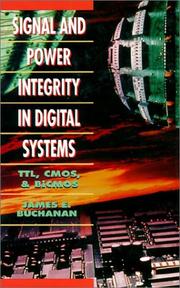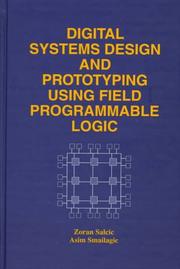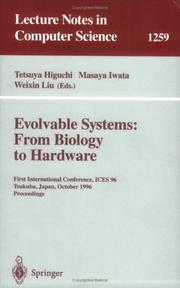| Listing 1 - 9 of 9 |
Sort by
|

ISBN: 0070087342 9780070087347 Year: 1996 Publisher: New York (N.Y.): McGraw-Hill,
Abstract | Keywords | Export | Availability | Bookmark
 Loading...
Loading...Choose an application
- Reference Manager
- EndNote
- RefWorks (Direct export to RefWorks)
Bipolar integrated circuits-design and construction --- Transistor-transistor logic circuits-design and construction --- Digital electronics-design and construction --- Very high speed integrated circuits-design and construction --- Metal oxide semiconductors, complementary-design and construction --- Metal oxide semiconductors, Complementary --- Transistor-transistor logic circuits --- Bipolar integrated circuits --- Digital electronics --- Very high speed integrated circuits
Book
ISBN: 0072460857 9780072460858 Year: 2005 Publisher: Boston (Mass.): McGraw-Hill,
Abstract | Keywords | Export | Availability | Bookmark
 Loading...
Loading...Choose an application
- Reference Manager
- EndNote
- RefWorks (Direct export to RefWorks)
Logic circuits --- Logic design --- VHDL (Computer hardware description language) --- Design and construction --- Data processing. --- Hardware : computertaal --- VHDL --- Logische circuits : ontwerp --- 681.3 --- Very High Speed Integrated Circuits Hardware Description Language (Computer hardware description language) --- VHSIC Hardware Description Language (Computer hardware description language) --- Computer assisted logic design --- Circuits, Logic --- Design and construction&delete& --- Data processing --- Computer hardware description languages --- Integrated circuits --- Computers --- Digital electronics --- Electronic circuits --- Interface circuits --- Switching circuits --- Switching theory --- Computer simulation --- Circuits --- 004.4 --- Logic circuits - Design and construction - Data processing. --- Logic design - Data processing.
Book
ISBN: 3642432565 3642276563 9786613705785 3642276571 1280795395 Year: 2012 Publisher: Heidelberg ; New York : Springer,
Abstract | Keywords | Export | Availability | Bookmark
 Loading...
Loading...Choose an application
- Reference Manager
- EndNote
- RefWorks (Direct export to RefWorks)
In three main divisions the book covers combinational circuits, latches, and asynchronous sequential circuits. Combinational circuits have no memorising ability, while sequential circuits have such an ability to various degrees. Latches are the simplest sequential circuits, ones with the shortest memory. The presentation is decidedly non-standard. The design of combinational circuits is discussed in an orthodox manner using normal forms and in an unorthodox manner using set-theoretical evaluation formulas relying heavily on Karnaugh maps. The latter approach allows for a new design technique called composition. Latches are covered very extensively. Their memory functions are expressed mathematically in a time-independent manner allowing the use of (normal, non-temporal) Boolean logic in their calculation. The theory of latches is then used as the basis for calculating asynchronous circuits. Asynchronous circuits are specified in a tree-representation, each internal node of the tree representing an internal latch of the circuit, the latches specified by the tree itself. The tree specification allows solutions of formidable problems such as algorithmic state assignment, finding equivalent states non-recursively, and verifying asynchronous circuits.
Circuits and systems. --- Logic circuits -- Computer-aided design. --- Logic circuits -- Design and construction. --- Systems engineering. --- Logic circuits --- Electrical & Computer Engineering --- Engineering & Applied Sciences --- Electrical Engineering --- Design and construction --- Computer-aided design --- Design and construction. --- Computer-aided design. --- Circuits, Logic --- Engineering. --- Logic design. --- Information theory. --- Electronic circuits. --- Circuits and Systems. --- Logic Design. --- Electronic Circuits and Devices. --- Information and Communication, Circuits. --- Computers --- Digital electronics --- Electronic circuits --- Interface circuits --- Switching circuits --- Switching theory --- Circuits --- Mathematics. --- Math --- Science --- Design, Logic --- Design of logic systems --- Electronic circuit design --- Machine theory --- Engineering systems --- System engineering --- Engineering --- Industrial engineering --- System analysis --- Communication theory --- Communication --- Cybernetics --- Electron-tube circuits --- Electric circuits --- Electron tubes --- Electronics

ISBN: 0792399358 1461378079 1461561256 9780792399353 Year: 2000 Publisher: Boston : Kluwer Academic,
Abstract | Keywords | Export | Availability | Bookmark
 Loading...
Loading...Choose an application
- Reference Manager
- EndNote
- RefWorks (Direct export to RefWorks)
Field-programmable logic has been available for a number of years. The role of Field-Programmable Logic Devices (FPLDs) has evolved from simply implementing the system `glue-logic' to the ability to implement very complex system functions, such as microprocessors and microcomputers. The speed with which these devices can be programmed makes them ideal for prototyping. Low production cost makes them competitive for small to medium volume productions. These devices make possible new sophisticated applications, and bring up new hardware/software trade-offs and diminish the traditional hardware/software demarcation line. Advanced design tools are being developed for automatic compilation of complex designs and routings to custom circuits. Digital Systems Design and Prototyping Using Field Programmable Logic covers the subjects of digital systems design and (FPLDs), combining them into an entity useful for designers in the areas of digital systems and rapid system prototyping. It is also useful for the growing community of engineers and researchers dealing with the exciting field of FPLDs, reconfigurable and programmable logic. The authors' goal is to bring these topics to students studying digital system design, computer design, and related subjects in order to show them how very complex circuits can be implemented at the desk. Digital Systems Design and Prototyping Using Field Programmable Logic makes a pioneering effort to present rapid prototyping and generation of computer systems using FPLDs. From the Foreword: `This is a ground-breaking book that bridges the gap between digital design theory and practice. It provides a unifying terminology for describing FPLD technology. In addition to introducing the technology it also describes the design methodology and tools required to harness this technology. It introduces two hardware description languages (e.g. AHDL and VHDL). Design is best learned by practice and the book supports this notion with abundant case studies.' Daniel P. Siewiorek, Carnegie Mellon University CD-ROM INCLUDED! Digital Systems Design and Prototyping Using Field Programmable Logic, First Edition includes a CD-ROM that contains Altera's MAX+PLUS II 7.21 Student Edition Programmable Logic Development Software. MAX+PLUS II is a fully integrated design environment that offers unmatched flexibility and performance. The intuitive graphical interface is complemented by complete and instantly accessible on-line documentation, which makes learning and using MAX+PLUS II quick and easy. The MAX+PLUS II version 7.21 Student Edition offers the following features: Operates on PCs running Windows 3.1, Windows 95 and Windows NT 3.51 and 4.0. Graphical and text-based design entry, including the Altera Hardware Description Language (AHDL) and VHDL. Design compilation for Product-term (MAX 7000S) and look-up table (FLEX 10K) device architectures. Design verification with full timing simulation.
Logic circuits --- -Field programmable gate arrays --- digitale technieken --- ontwerpen --- prototype --- digitale systemen --- FPLD --- AHDL --- VHDL --- field programmable logic --- Field programmable logic arrays --- FPGAs --- Gate array circuits --- Programmable logic devices --- Circuits, Logic --- Computers --- Digital electronics --- Electronic circuits --- Interface circuits --- Switching circuits --- Switching theory --- Design and construction --- Circuits --- Contains audio-visual material --- Field programmable gate arrays --- Field programmable gate arrays. --- Design and construction. --- Logische schakelingen. --- Ontwerpen. --- Design --- Electronic circuits. --- Electrical engineering. --- Computer-aided engineering. --- Circuits and Systems. --- Electrical Engineering. --- Computer-Aided Engineering (CAD, CAE) and Design. --- CAE --- Engineering --- Electric engineering --- Electron-tube circuits --- Electric circuits --- Electron tubes --- Electronics --- Data processing --- Logic circuits - Design and construction

ISBN: 0071244824 9780071244824 Year: 2005 Publisher: Boston (Mass.): McGraw-Hill,
Abstract | Keywords | Export | Availability | Bookmark
 Loading...
Loading...Choose an application
- Reference Manager
- EndNote
- RefWorks (Direct export to RefWorks)
Logic circuits --- Logic design --- VHDL (Computer hardware description language) --- Design and construction --- Data processing. --- 621.3.049 --- 681.3*D1 --- 519.85 --- 621.377.6 --- 621.377.6 Digital stores, registers, storage devices --- Digital stores, registers, storage devices --- 519.85 Mathematical programming --- Mathematical programming --- 621.3.049 Construction of the electric circuit --- Construction of the electric circuit --- 681.3*D1 Programming techniques--See also {681.3*E} --- Programming techniques--See also {681.3*E} --- Logic circuits - Design and construction - Data processing. --- Logic design - Data processing.
Book
ISBN: 9780073529530 0073529532 9780071287654 0071287655 9780071268806 9780077210724 0077210727 Year: 2009 Publisher: Boson (Mass.): McGraw-Hill,
Abstract | Keywords | Export | Availability | Bookmark
 Loading...
Loading...Choose an application
- Reference Manager
- EndNote
- RefWorks (Direct export to RefWorks)
- Design concepts - Introduction to logic circuits - Implementation technology - Optimized implementation of logic functions - Number representation and arithmetic circuits - Combinational-circuit building blocks - Flip-flop, registers, counters, and a simple processor - Synchonous sequential - Asybchronous sequential - Testing of logic circuits - Computer aided design tools - Vhdl reference
Logic circuits --- Logic design --- VHDL (Computer hardware description language) --- Design and construction --- Data processing --- 681.3*B6 --- 681.3*B61 --- Logic design (Hardware) --- Design styles: cellular arrays and automata; combinational logic; logic arrays; memory control and access; memory used as logic; parallel and sequential circuits (Logic design) --- 681.3*B6 Logic design (Hardware) --- VHDL --- digitale technieken --- digitale schakelingen --- digitale elektronica --- combinatorische schakelingen --- Electrical engineering --- VHDL (very high speed integrated circuit hardware description language) --- Very High Speed Integrated Circuits Hardware Description Language (Computer hardware description language) --- VHSIC Hardware Description Language (Computer hardware description language) --- Computer hardware description languages --- Integrated circuits --- Computer assisted logic design --- Circuits, Logic --- Computers --- Digital electronics --- Electronic circuits --- Interface circuits --- Switching circuits --- Switching theory --- Design and construction&delete& --- Computer simulation --- Circuits --- Logic circuits - Design and construction - Data processing --- Logic design - Data processing
Book
ISBN: 0070125910 9780070125919 Year: 2000 Publisher: Boston: McGraw-Hill,
Abstract | Keywords | Export | Availability | Bookmark
 Loading...
Loading...Choose an application
- Reference Manager
- EndNote
- RefWorks (Direct export to RefWorks)
Logic circuits --- Logic design --- VHDL (Computer hardware description language) --- Design and construction --- Data processing --- -Logic circuits --- -VHDL (Computer hardware description language) --- VHDL --- digitale technieken --- logic circuits --- 004.436.2 --- VHDL very high speed hardware description language --- digitale elektronica --- digitale schakelingen --- hardware --- ontwerpen --- Very High Speed Integrated Circuits Hardware Description Language (Computer hardware description language) --- VHSIC Hardware Description Language (Computer hardware description language) --- Computer hardware description languages --- Integrated circuits --- Circuits, Logic --- Computers --- Digital electronics --- Electronic circuits --- Interface circuits --- Switching circuits --- Switching theory --- Design, Logic --- Design of logic systems --- Electronic circuit design --- Machine theory --- hardware-descriptietaal --- Computer simulation --- Circuits --- Contains audio-visual material --- Computer assisted logic design --- Design and construction&delete& --- Logic circuits - Design and construction - Data processing --- Logic design - Data processing
Book
ISSN: 18761100 ISBN: 9048196434 9048196442 1283640775 9400797982 Year: 2013 Volume: v. 115 Publisher: New York : Springer,
Abstract | Keywords | Export | Availability | Bookmark
 Loading...
Loading...Choose an application
- Reference Manager
- EndNote
- RefWorks (Direct export to RefWorks)
Integrated circuits (ICs) increasingly exhibit uncertain characteristics due to soft errors, inherently probabilistic devices, and manufacturing variability. As device technologies scale, these effects can be detrimental to the reliability of logic circuits. To improve future semiconductor designs, this book describes methods for analyzing, designing, and testing circuits subject to probabilistic effects. The authors first develop techniques to model inherently probabilistic methods in logic circuits and to test circuits for determining their reliability after they are manufactured. Then, they study error-masking mechanisms intrinsic to digital circuits and show how to leverage them to design more reliable circuits. The book describes techniques for: • Modeling and reasoning about probabilistic behavior in logic circuits, including a matrix-based reliability-analysis framework; • Accurate analysis of soft-error rate (SER) based on functional-simulation, sufficiently scalable for use in gate-level optimizations; • Logic synthesis for greater resilience against soft errors, which improves reliability using moderate overhead in area and performance; • Test-generation and test-compaction methods aimed at probabilistic faults in logic circuits that facilitate accurate and efficient post-manufacture measurement of soft-error susceptibility.
Engineering. --- Logic circuits -- Design. --- Logic circuits -- Testing. --- Uncertainty (Information theory). --- Logic circuits --- Uncertainty (Information theory) --- Electrical & Computer Engineering --- Engineering & Applied Sciences --- Electrical Engineering --- Design --- Testing --- Logic circuits. --- Measure of uncertainty (Information theory) --- Shannon's measure of uncertainty --- System uncertainty --- Circuits, Logic --- Systems engineering. --- Computer science. --- Computer hardware. --- Operating systems (Computers). --- Logic design. --- Algebra --- Circuits and Systems. --- Arithmetic and Logic Structures. --- Computer Hardware. --- Performance and Reliability. --- Logic Design. --- Symbolic and Algebraic Manipulation. --- Data processing. --- Design, Logic --- Design of logic systems --- Digital electronics --- Electronic circuit design --- Machine theory --- Switching theory --- Computer operating systems --- Computers --- Disk operating systems --- Systems software --- Informatics --- Science --- Engineering systems --- System engineering --- Engineering --- Industrial engineering --- System analysis --- Operating systems --- Design and construction --- Information measurement --- Probabilities --- Questions and answers --- Electronic circuits --- Interface circuits --- Switching circuits --- Circuits --- Electronic circuits. --- Arithmetic and logic units, Computer. --- Computer software—Reusability. --- Computer science—Mathematics. --- Arithmetic and logic units, Computer --- Computer arithmetic --- Electronic digital computers --- Electron-tube circuits --- Electric circuits --- Electron tubes --- Electronics

ISBN: 3540631739 3540692045 9783540631736 Year: 1997 Volume: 1259 Publisher: Berlin, Heidelberg : Springer Berlin Heidelberg : Imprint: Springer,
Abstract | Keywords | Export | Availability | Bookmark
 Loading...
Loading...Choose an application
- Reference Manager
- EndNote
- RefWorks (Direct export to RefWorks)
This book constitutes the strictly refereed post-conference proceedings recording the scientific progress achieved at the First International Conference on Evolvable Systems: From Biology to Hardware, ICES'96, held in Tsukuba, Japan, in October 1996. The volume presents 33 revised full papers including several invited contributions surveying the state of the art in this emerging area of research and development. The volume is divided into topical sections on evolware, cellular systems, engineering applications of evolvable hardware systems, evolutionary robotics, innovative architectures, evolvable systems, evolvable hardware, and genetic programming.
Evolutionary programming (Computer science) --- Evolutionary computation --- Digital integrated circuits --- Logic circuits --- Congresses. --- Design and construction --- Computer Science --- Engineering & Applied Sciences --- Congresses --- Circuits, Logic --- Computer science. --- Logic design. --- Architecture, Computer. --- Computers. --- Artificial intelligence. --- Computer simulation. --- Bioinformatics. --- Computational biology. --- Computer Science. --- Artificial Intelligence (incl. Robotics). --- Computer System Implementation. --- Logic Design. --- Computation by Abstract Devices. --- Simulation and Modeling. --- Computer Appl. in Life Sciences. --- Computer network architectures. --- Biology --- Artificial Intelligence. --- Data processing. --- Architectures, Computer network --- Network architectures, Computer --- Computer architecture --- Computer modeling --- Computer models --- Modeling, Computer --- Models, Computer --- Simulation, Computer --- Electromechanical analogies --- Mathematical models --- Simulation methods --- Model-integrated computing --- Design, Logic --- Design of logic systems --- Digital electronics --- Electronic circuit design --- Machine theory --- Switching theory --- Informatics --- Science --- AI (Artificial intelligence) --- Artificial thinking --- Electronic brains --- Intellectronics --- Intelligence, Artificial --- Intelligent machines --- Machine intelligence --- Thinking, Artificial --- Bionics --- Cognitive science --- Digital computer simulation --- Electronic data processing --- Logic machines --- Self-organizing systems --- Fifth generation computers --- Neural computers --- Bioinformatics . --- Computational biology . --- Bioinformatics --- Bio-informatics --- Biological informatics --- Information science --- Computational biology --- Systems biology --- Automatic computers --- Automatic data processors --- Computer hardware --- Computing machines (Computers) --- Electronic calculating-machines --- Electronic computers --- Hardware, Computer --- Computer systems --- Cybernetics --- Calculators --- Cyberspace --- Architecture, Computer --- Data processing --- Evolutionary programming (Computer science) - Congresses. --- Evolutionary computation - Congresses. --- Digital integrated circuits - Design and construction - Congresses. --- Logic circuits - Design and construction - Congresses. --- Computer architecture.
| Listing 1 - 9 of 9 |
Sort by
|

 Search
Search Feedback
Feedback About UniCat
About UniCat  Help
Help News
News